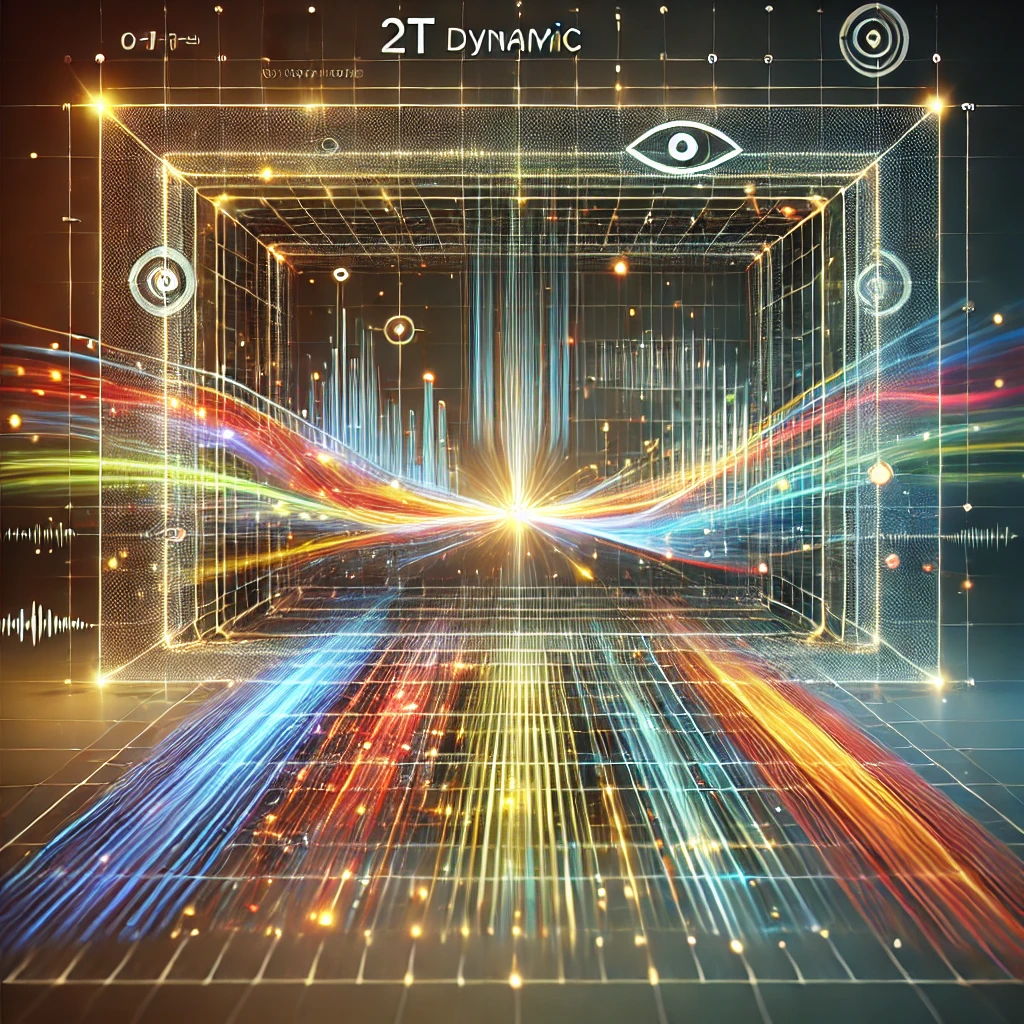Physics 2T: Dynamic Video
Welcome to 2T: The dynamic layer where scalar transformations come to life. Here, we explore how individual values (scalars) evolve into dynamic, real-time representations of motion and interaction in 3D space.
What is 2T?
2T is the second layer of transformations, expanding scalar values from 1T into dynamic, real-time 3D representations. Imagine a video representation of scalar data being visualized in 3D space, tracking changes over time using pulse pings that measure and map this transformation.
In the 2T Dynamic Video framework, energy resolution plays a vital role in creating seamless projections. The ABEC framework introduces a sophisticated method for managing unresolved energy, transforming it into structured flows that fuel dynamic, real-time holographic systems.
2T: Dynamic Video
The 2T Dynamic Video layer captures the field of view, interpreting light speed interactions and color bandwidth to create a real-time dynamic visual map. Unlike WIR, which operates on volume-to-volume coherence, 2T focuses on the observer's field of view, rendering spatial dynamics visible in the moment.
Key Principles of 2T
- Field of View-Centric: Focuses on spatial interactions within the visible frame.
- Color Bandwidth Encoding: Translates energy and intensity into dynamic color representations.
- Real-Time Interplay: Captures temporal changes and adjusts the field of view dynamically.
How 2T Works
- Foundation in 1T: Scalars from 1T define parameters for dynamic fields, creating adaptive grids.
- Light-Speed Calculations: Ensures real-time mapping of spatial and temporal interactions.
- Field of View Logic: Focuses on visible interactions, reducing system complexity.
Applications of 2T Dynamic Video
- Interactive Systems: Enables adaptive, real-time interfaces.
- Holographic Displays: Creates dynamic, perspective-based holographic visuals.
- Energy and Signal Tracking: Visualizes energy flows within localized environments.

"A dynamic video feed broadcast out with referenced anchor signaling creates a projection of holographic map relative to all other in the Spatial reference. Helpful for OUR temporal reference and survey locking."
How Pulse Pings and Selective Tracking Work
In the Chroma system, pulse pings work collaboratively, selectively analyzing data in real time. Rather than capturing every possible detail, these pings act much like a choir in unison—each ping focused on its task but aware of the system’s overall structure. This allows the system to be both precise and adaptive, adjusting based on key observations while minimizing unnecessary data overload.
When plugged into the CAD NET, the system uses this selective pinging to analyze a light replica of the data cubes would traditionally track. The survey data collected by CAD NET allows the system to focus on relevant details, creating a streamlined view of the environment without losing sight of important dynamics.
This process enables the system to not only monitor real-time transformations but also to selectively enhance areas of interest, ensuring the 3D map remains both accurate and efficient in terms of processing power.
The Role of Time in 2T
Time is integral to 2T, anchoring each scalar transformation. The pulse pings are sent at defined intervals, allowing the system to track how each point shifts and evolves. This creates a smooth, continuous video of objects or values moving and interacting in 3D space.
These transformations happen across relative time, capturing the full trajectory of how scalars, vectors, and cubes evolve in real-time video format.
ABEC Framework: Energizing 2T Projections
The ABEC framework introduces a dynamic approach to managing unresolved energy, transforming it into structured flows that fuel 2T’s dynamic projections. Acting as a universal energy adapter, ABEC harmonizes chaotic inputs into coherent waveforms, optimizing energy distribution for holographic systems.
Resolving Energy for Projection
At its core, the ABEC framework ensures that unresolved energy is captured and transformed through three key steps:
- Energy Absorption: Captures raw, chaotic energy into ABEC pools for phase alignment.
- Waveform Alignment: Smooths energy inputs into structured, coherent waveforms suitable for projection.
- Redistribution: Fuels dynamic projections, creating seamless real-time visualizations in 2T.
Mathematical Representation
The clarity of a 2T dynamic projection depends on the proportion of resolved energy to total energy:
\( P_{clarity} = \frac{E_{resolved} \times \phi_{alignment}}{E_{total}} \)
Where \( P_{clarity} \) is projection clarity, \( E_{resolved} \) is the harmonized energy output, \( \phi_{alignment} \) is the efficiency of phase alignment, and \( E_{total} \) is the total input energy.
Applications in 2T
- Energy Smoothness: ABEC pools provide consistent energy flow, preventing stuttering or interruptions.
- Temporal Stability: Phase-aligned energy ensures frame-to-frame consistency in dynamic videos.
- Adaptive Feedback: ABEC dynamically adjusts outputs based on environmental factors, enhancing projection clarity.
Applications of Pulse-Ping Dynamic Videos
Using pulse pings and cubes to measure dynamic videos has broad applications in the Chroma framework, such as:
- Object Motion: Accurately map the motion of physical objects as they traverse the 3D environment.
- Energy Flow: Track energy as it moves and transforms through the space in real-time.
- Field Interactions: Visualize how electromagnetic, gravitational, or other fields interact dynamically over time.
- Data Visualization: Observe how data or information flows and interacts within a system, as cubes track transformations over time.
Next Steps
Continue exploring the Chroma system by delving into the WOW Perspective concept, where we examine how changing the observer's perspective can reveal new layers of understanding within these dynamic transformations.
Explore WOW Perspective